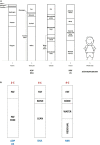Preterm birth and metabolic implications on later life: A narrative review focused on body composition
- PMID: 36185669
- PMCID: PMC9521164
- DOI: 10.3389/fnut.2022.978271
Preterm birth and metabolic implications on later life: A narrative review focused on body composition
Abstract
Preterm newborn infants are characterized by low body weight and lower fat mass at birth compared with full-term newborn neonates. Conversely, at term corrected age, body fat mass is more represented in preterm newborn infants, causing a predisposition to developing metabolic syndrome and cardiovascular diseases in later life with a different risk profile in men as compared with women. Postnatal growth is a complex change in anthropometric parameters and body composition. Both quantity and quality of growth are regulated by several factors such as fetal programming, early nutrition, and gut microbiota. Weight gain alone is not an optimal indicator of nutritional status as it does not accurately describe weight quality. The analysis of body composition represents a potentially useful tool to predict later metabolic and cardiovascular risk as it detects the quality of growth by differentiating between fat and lean mass. Longitudinal follow-up of preterm newborn infants could take advantage of body composition analysis in order to identify high-risk patients who apply early preventive strategies. This narrative review aimed to examine the state-of-the-art body composition among born preterm children, with a focus on those in the pre-school age group.
Keywords: body composition; early nutrition; fetal programming; microbiota; preschool; preterm.
Copyright © 2022 Casirati, Somaschini, Perrone, Vandoni, Sebastiani, Montagna, Somaschini and Caccialanza.
Conflict of interest statement
The authors declare that the research was conducted in the absence of any commercial or financial relationships that could be construed as a potential conflict of interest.
Figures



References
-
- ICD-10 Version:2016. Apps.Who.Int. (2022). Available online at: http://apps.who.int/classifications/icd10/browse/2016/en#!/P05.9 (accessed March 16, 2022)
Publication types
LinkOut - more resources
Full Text Sources

